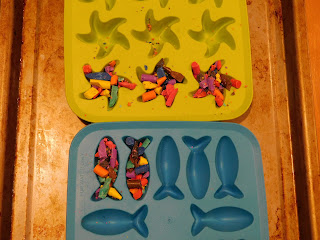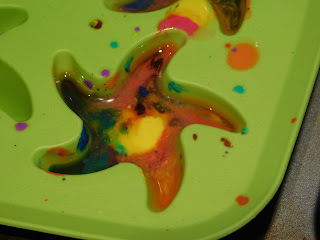Despite not actually drawing much with wax crayons, we have a surprisingly large number of small pieces from them rolling off the table and smashing on the floor. I have been collecting them, thinking that it would be nice to do something with them, rather than throwing them away. I decided that we could combine recycling the bits of crayon into big multicoloured crayons with learning a bit about melting and the differences between solids and liquids.
The first step was to take the solid bits of crayon and smash them up to make sure they were all small enough. We put the crayons in a sandwich bag for this, and I made a bit of a mistake in arming a 3 year old with a rolling pin, which I'd strongly suggest isn't the best approach if you're considering trying this. He had fun bashing the bag of crayons on a chopping board, but the rolling pin did end up being wielded a little wildly, and I was quite glad his brother was sleeping a safe distance away at the time. The end result was a bag of small pieces of crayon.
 |
| Scooping broken crayons into moulds |
The next step was to find something to shape our recycled crayons. We used some sea creature shaped silicone ice cube moulds. In hindsight, the shapes have too many pointy bits, and I'd have been better with the
pineapple one we used for some basic coding. But as it was, we scooped some of our bag of crayon bits into a few starfish shapes and a few fish and discussed how the bits of crayon were hard and didn't take on the shape of the mould.
 |
| Crayon pieces ready to melt |
I then heated the oven to 100°C (before we did some baking at a higher temperature) and we put the silicone moulds on a baking tray and into the oven for 10 minutes. It was a little longer than I'd intended as the baby woke whilst it was in the oven, so I suspect a few minutes less would have been fine. When we took it out of the oven, we carefully (with the small boy sufficiently far away that he couldn't touch the hot tin or wax) had a look at the molten wax, and saw how it had taken on the shape of the mould and flowed around when I tilted the tin.
 |
| Molten wax crayon |
We talked briefly about how ice stops being hard and having a fixed shape when it melts and turns into water, and how the wax had melted in the oven. I explained that different things melt at different temperatures, so water is liquid at room temperature, but wax crayons are solid. I'm not sure how much he engaged with the explanation though as he was quite excited by the pretty patterns in the molten crayons!
 |
| The finished crayons (which lost a few bits when released from the moulds) |
We let the crayons cool and then I attempted to pop them out of the moulds. This is where the long thin starfish arms and the fish tails didn't work very well as many of them cracked. Still, the small boy was delighted with the new crayons. Did he want to draw with them though...? No. He wanted to admire them, count them, and suggested they might be a nice present for his cousin...!
We have drawn with them since, and I showed him how the colour changes as you use them, but he's no keener to draw or write with them than with the original crayons which is a bit of a shame! His baby brother on the other hand is rather keener on both drawing and eating them... maybe I'll try this again in the future with the little one as he's a bit more into arty things, even at the age of not-quite-one, than his brother has ever been.
Comments
Post a Comment
All comments are moderated before being published.